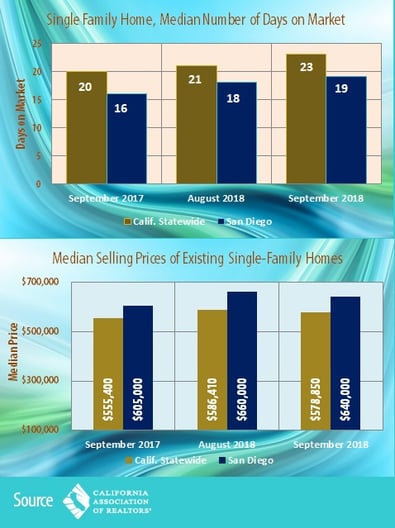
California’s housing market “continued to deteriorate” in September, according to the latest housing market report from the California Association of REALTORS® (C.A.R). Mortgage rates remain affordable while demand for existing homes is slowing, home prices are rising at a slower rate and a tight supply of available homes, still low, is increasing.
In September, C.A.R. said the state’s housing market posted its largest year-over-year sales decline since March 2014. In addition, home sales remained below the 400,000-level sales benchmark for the second consecutive month, indicating that the market is slowing as many potential buyers put their homeownership plans on hold.
C.A.R. said September’s statewide median home price dropped to $578,850 in September. The September 2018 statewide median price was down 2.9 percent from $596,410 in August 2018 but up 4.2 percent from a revised $555,400 in September 2017.
In San Diego County, the median price of a single-family home in San Diego County was $640,000 in September 2018, up from $605,000 during the same month a year ago, according to CAR. The median price in September 2018 was down 3 percent from $660,000 in August 2018.
Closed escrow sales of existing, single-family detached homes in California totaled a seasonally adjusted annualized rate of 382,550 units in September, according to information collected by C.A.R. from more than 90 local REALTOR® associations and MLSs statewide. The statewide annualized sales figure represents what would be the total number of homes sold during 2018 if sales maintained the September pace throughout the year. It is adjusted to account for seasonal factors that typically influence home sales.
“The housing market continued to deteriorate and the decline in sales worsened as interest rates remained on an upward trend,” said C.A.R. President Steve White. “More would-be buyers are self-sidelining as they believe home prices will start to come down soon, making housing more affordable despite rising interest rates. Tax reform, which increases the cost of homeownership, also is contributing to the decline, especially in high-cost areas such as the San Francisco Bay Area and Orange County.”
“Price appreciations have slowed in the last few months and inventory has risen considerably since June when the statewide median price hit a new peak,” said C.A.R. Senior Vice President and Chief Economist Leslie Appleton-Young. “Buyers are becoming increasingly concerned about market developments and are reluctant to purchase at the prevailing market price. As such, the deceleration in price growth will likely continue in coming months.”
Other key points from C.A.R.’s September 2018 resale housing report included:
- -- Homes are taking longer to sell than they did just a few months ago. The median number of days it took to sell a California single-family home ticked up from 20 days in September 2017 to 23 days in September 2018, a sign that market competitiveness is not as heated as it was in 2017. The statewide number of days for August 2018 was 21 days. Meanwhile, in San Diego County, the median number of days a home remained unsold on the market was 19 days in September 2018, compared to 18 days in August 2018 and 16 days in September 2017.
- -- Statewide active listings rose for the sixth consecutive month following 33 straight months of declines, increasing 20.4 percent from the previous year. September’s listings increase was the biggest in nearly four years.
- -- The Unsold Inventory Index, which is a ratio of inventory over sales, rose again to 4.2 months in September 2018 from 3.3 months in September 2017. It was the highest level in 31 months. The index measures the number of months it would take to sell the supply of homes on the market at the current sales rate.
- -- The 30-year, fixed-mortgage interest rates averaged 4.63 percent in September, up from 3.81 percent in September 2017, according to Freddie Mac. The five-year, adjustable mortgage interest rate also increased in September to an average of 3.94 percent from 3.16 percent from September 2017.
- U.S. home sales fell for the sixth straight month in September 2018, a sign that housing is remaining a weak spot for the economy. The National Association of REALTORS® said that sales declined 3.4 percent in September, the biggest drop in 2 ½ years, to a seasonally adjusted annual rate of 5.15 million. That’s the lowest sales pace since November 2015.
- Rising mortgage rates, paired with already high home prices, are giving pause to homebuyers and are partly to blame for the slowdown in sales, according to CoreLogic. With some rates running at around 5 percent for 30-year fixed-rate loans, CoreLogic reported that mortgage rates this summer reached the highest level in seven years, making it harder for some buyers to enter the market.
- Mortgage payments are rising faster than home values. A new Zillow analysis report found that monthly mortgage payments are rising at significantly higher levels than home values. For example, in San Diego County, the median home value rose just 4.9 percent year-over-year while the monthly mortgage payments jumped by 13.6 percent from a year ago, according to Zillow.
- According to Redfin, San Diego County’s housing inventory level climbed 30.7 percent year-over-year in September, trailing only San Jose (82.7 percent) and Seattle (54.5 percent). Inventory levels may have climbed, but Redfin’s recent overall assessment for San Diego County still gives us an 84 out of 100 ranking on a competitive scale with 100 being the most competitive.
- Rents have stabilized recently, which means many would-be buyers may not feel as much pressure to buy a home right now. However, looking ahead, San Diego County's average rent is projected to soar to $2,187 by 2020, according to a forecast by the USC Lusk Center for Real Estate in partnership with Beacon Economics. The USC forecast estimates that in two years average monthly rents in San Diego County will increase by $209 over their current levels. It also predicts rents will rise by $91 in Los Angeles County, by $52 in Orange County, by $107 in Ventura County and by $78 in the Inland Empire. The forecast also said while San Diego County's vacancy rate was unchanged at 3.94 percent in 2018, it is projected to drop to 3.75 percent in 2020 despite several thousand units that are either under construction or will be in development soon.
- Analysts remain mostly optimistic about the broader economy. Most forecast growth will top 3 percent for an annual rate in the July-September quarter, after a robust expansion of 4.2 percent in the second quarter.
- San Diego County created 700 jobs in September 2018 and added 27,000 jobs in the past year, according to a recent jobs report from the California Economic Development Department. The largest month-over-month increases occurred in the government sector, which added 5,100 jobs. With the creation of 14,700 jobs, the professional and business services sector reported the largest year-over gains. San Diego County's unemployment rate fell from a revised 3.4 percent in August to 3.2 percent in September. By comparison, the unadjusted unemployment rate was 3.9 percent for California and 3.6 percent for the nation during the same time frame, according to the report.
